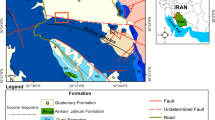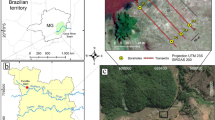Abstract
‘Water in Istanbul: Rising to the Challenge?’ is the title of a new 24-month project which brings archaeologists, historians, engineers, and urban scientists together to explore the historical water management infrastructure and evolution of water technology in the city of Istanbul through history. One of the outcomes of this research will be producing a hydraulic model that will help us to understand how the past system functioned and was managed. This in-depth research also hopes to bring a new perspective for the contemporary water-related challenges. The archaeological field work geographically focuses on the I. Hill of the Byzantine city where Ottoman imperial palace called Topkapı gets located over. This is the most challenging topographical area regarding the historical water distribution which functioned according to the principle of gravity. Non-destructive survey methods are crucial in such fragile archaeological areas. Also, the bureaucratical difficulties related to the legal permissions make it a necessity to apply archaeogeophysical methods. In the first field work phase, we preferred ground-penetrating radar (GPR) in order to identify the remains, including supply lines providing freshwater to the Topkapı area. Our survey based on previous research by Hülya Tezcan and the archaeological survey results of Çiğdem Özkan Aygün in order to identify the areas for investigation with GPR. Thanks to GPR, the location, geometry, and depth of the buried historical structures would be possible to determine. GPR, which provides high-resolution information from shallow areas, is a geophysical method frequently used, especially in archaeogeophysical studies. The method is based on recording the travel times of reflected and scattered electromagnetic waves, which are sent to the subsurface with high-frequency antennas, with a receiver. In this study, results of the GPR study, which was carried out using a 350 MHz centre antenna frequency to detect the historical water channels beneath the area surrounding the Topkapı Palace are mentioned. After processing the data sensitively, GPR sections were interpreted and all possible water channels were detected. Depths of the detected channels are between 2 and 5 m below the surface.
Access provided by Autonomous University of Puebla. Download conference paper PDF
Similar content being viewed by others
Keywords
- Archaeology
- Archaeogeophysics
- Ground-penetrating radar
- Hydraulics
- Water channels
- Cisterns
- Drainage
- Topkapı Palace
- Hagia Sophia
- İstanbul
1 Introduction
‘Water in Istanbul’ project is a multidisciplinary and multinational project bringing together the academicians from İstanbul Technical University, University of Edinburgh and Northumbria University. This work is supported by Scientific Research Projects Department of Istanbul Technical University. Project Number: 43072 and The British Academy, ‘Knowledge Frontiers: International Interdisciplinary Research 2021’ Scheme.
İstanbul as a city with a history of more than 1700 years and challenging for freshwater since its foundation makes it a perfect laboratory for learning from the past and generating sustainable solutions for the future. Topkapı Palace area is a micro-scale representation of the Eastern Roman and Ottoman historical water technology in Istanbul. That’s why we focus on the Topkapi for our multidisciplinary fieldwork and archival research which will provide data to model the Ottoman water management system.
Dr. Özkan Aygün of Istanbul Technical University (İTÜ) whose work on Istanbul’s past water systems has provided new evidences for the subterranean hydraulic infrastructure of Hagia Sophia has also conducted an archaeological survey for documenting the network of cisterns, channels, and wells of Topkapı and surroundings (Özkan Aygün, 2010; Özkan Aygün & Güney, 2014; Özkan Aygün & Kaçan, 2014). Together with her findings, the data coming from Hülya Tezcan (1989) and Kazım Çeçen’s (Çeçen & Kolay, 1997) publications construct the basis of the literal sources of this project.
Application of GPR methods has a crucial role for the new data to be obtained as a part of Dr. Aygün’s survey for this new project. Those results are being shared with hydraulic engineers and modelled using GIS and engineering software to enable research on the functionality of the system.
2 Application of Ground-Penetrating Radar Method
Ground-penetrating radar is an electromagnetic method that sends high-frequency signals into the ground, especially in shallow geophysical surveys. Ground-penetrating radar was first used in glacier studies by the German geophysicist Walter Stern (1929). The method is based on the principle of recording electromagnetic waves sent into the ground by a transmitting antenna, reflected and scattered from subsurface layers, and recorded by a receiving antenna. Depending on the travel time of the reflected and scattered waves recorded by the receiving antenna, the presence, position, and geometry of structures in the ground can be determined. The electromagnetic signal, which has a harmonic structure, contains a centre frequency. The centre frequency determines the penetration depth, the amount of absorption, the vertical resolution, and the degree of scattering. As the frequency increases, the temporal resolution increases; however, the penetration depth decreases as absorption increases. Conversely, information is collected with a lower resolution from a higher penetration depth Telford et al. (1990).
In this study, approximately 5 km of data was collected using shielded antenna with a central frequency of 350 MHz (Fig. 1, yellow lines). Since the data collection was carried out in an urban environment, the external disturbances that may affect the electro wave were identified individually to consider during the analysis. Due to the presence of narrow areas in the study area, the data were collected in 4, in some cases 5, parallel profiles spaced 0.5 m apart. The data collection parameters were a sampling interval of 0.512 ns, trig-interval of 0.02 m, and recording length of 250 ns.
The collected raw ground-penetrating radar data were exposed to a sensitive data processing process. Different mathematical approaches are used to improve the quality of the signal, allowing an accurate understanding of the geophysical response from the ground. Ground-penetrating radar sections are analysed by applying various data processing steps to obtain the most realistic image of the subsurface. The data were subjected to different data processing steps such as 1D filtering (e.g. de-wow, bandpass, notch, deconvolution), 2D filtering (e.g. running average, background removal), start time correction, static correction, gain correction, frequency–wavenumber filter, velocity analysis, and migration.
3 Results
The analysis and interpretation of the ground-penetrating radar sections revealed geophysical signatures that are considered to be water channels and associated structures. In the GPR section shown in Fig. 2, which belongs to one of the profiles near the Topkapı Palace Bab-ı Hümayun Gate, hyperbolic features with a depth of approximately 1.5 m and a width of about 1.5 m are interpreted as three adjacent water channel structures in this site.
4 Discussion
When the penetration depth of the GPR sections is analysed, it is concluded that the structure signatures obtained could be lost in some places. Since the characteristics of the topsoil cover are different in the study area and the dielectric properties change due to varying water-holding properties, it is concluded that the 350-MHz antenna is insufficient in some areas. Therefore, it has been planned to investigate the suspected areas in detail using antennas with a larger wavelength of the source signal. With the 250-MHz antenna, the second phase of the study has started and approximately 3 km of data has been collected. The 250 MHz antenna data strongly follow the findings of the 350 MHz antenna data and reveal new information about deeper structures. The new findings suggest that some water channels may go even further down more than 5 m. Thus, lower-frequency data are planned to be collected in the third phase of the study.
5 Conclusions
It has been proven by many studies that GPR surveys are highly effective for archaeological sites in urban areas (Basile et al., 2000; Leucci & Negri, 2006; Leucci et al., 2016; Rabbel et al., 2015). Through this study, the subterranean historical water structures beneath the I. Hill of İstanbul are being studied by the help of GPR for the first time, with very promising results.
References
Basile, V., Carrozzo, M. T., Negri, S., Nuzzo, L., Quarta, T., & Villani, A. V. (2000). A ground penetrating radar survey for archaeological investigations in urban area (Lecce, Italy). Journal of Applied Geophysics, 44, 15–32.
Çeçen, K., & Kolay, C. (1997). Topkapı Sarayı’na Su Sağlayan İsale Hatları. İSKİ Yayınları.
Leucci, G., & Negri, S. (2006). Use of ground penetrating radar to map subsurface archaeological features in an urban area. Journal of Archaeological Science, 33, 502–512.
Leucci, G., De Giorgi, L., Di Giacomo, G., Ditaranto, I., Miccoli, I., & Scardozzi, G. (2016). 3D GPR survey for the archaeological characterization of the ancient Messapian necropolis in Lecce, South Italy. Journal of Archaeological Science: Reports, 7, 302–390.
Özkan Aygün, Ç. (2010). New findings on Hagia Sophia Subterranean and its Surroundings. Bizantinistica: Fondazione Centro Italiano di studi sull’alto Medioevo di Spoleto,12, 57–108.
Özkan Aygün, Ç., & Güney, C. (2014). Application of ROV, subbottom profiler and gis at archaeological surveys cases of Hazar Lake Sunken Settlement and I. Hill of Constantinople, Hagia Sophia, Topkapı Palace and Hippodrome, 20th Annual Meeting of the European Association of Archaeologists, Abstracts, pp. 10–14. Istanbul/Turkey.
Özkan Aygün, Ç., & Kaçan, M. (2014). New findings of cisterns, wells, galleries and other water structures on the First Hill of İstanbul: Researches at Hagia Sophia, Topkapı Palace and Hippodrome. ISTYAM (International Istanbul Historical Peninsula Symposium—2013), pp. 258–279. İstanbul.
Rabbel, W., Erkul, E., Stümpel, H., Wunderlich, T., Pašteka, R., Papco, J., Niewöhner, P., Bariş, Ş, Çakin, O., & Pekşen, E. (2015). Discovery of a Byzantine Church in Iznik/Nicaea, Turkey: An educational case history of geophysical prospecting with combined methods in urban areas. Archaeological Prospection, 22, 1–20.
Stern, W. (1929). Versuch einer elektrodynamischen Dickenmessung von Gletschereis. Gerlands Beitrage Zur Geophysik, 23, 292–333.
Telford., W. M., Geldart, L. P., & Sheriff, R. E. (1990). Applied Geophysics. Cambridge University Press. Cambridge.
Tezcan, H. (1989). Topkapı Sarayı Çevresinin Bizans Devri Arkeolojisi. Türkiye Turing ve Otomobil Kurumu Yayınları. İstanbul.
Author information
Authors and Affiliations
Corresponding author
Editor information
Editors and Affiliations
Rights and permissions
Copyright information
© 2024 The Author(s), under exclusive license to Springer Nature Switzerland AG
About this paper
Cite this paper
Özkan-Aygün, Ç. et al. (2024). Ground-Penetrating Radar Application for ‘Water in İstanbul’ Project. In: Bezzeghoud, M., et al. Recent Research on Geotechnical Engineering, Remote Sensing, Geophysics and Earthquake Seismology. MedGU 2022. Advances in Science, Technology & Innovation. Springer, Cham. https://doi.org/10.1007/978-3-031-48715-6_41
Download citation
DOI: https://doi.org/10.1007/978-3-031-48715-6_41
Published:
Publisher Name: Springer, Cham
Print ISBN: 978-3-031-48714-9
Online ISBN: 978-3-031-48715-6
eBook Packages: Earth and Environmental ScienceEarth and Environmental Science (R0)






